Janis Freegard's Blog, page 3
July 22, 2023
Whose Poetry Gets Published in Aotearoa?
Yes, it’s time for more poetry pies!
Background
As a little side project, from time to time I analyse book titles published in Aotearoa New Zealand in any given year. I break the titles down by the gender and ethnicity of their authors. I do this because I’m curious to know how well the list of publications reflects our national population and because I like things to be fair.
Back when I started doing this in 2008, I was only looking at poetry titles by gender. Later, I started looking at ethnicity as well, and subsequently added fiction titles to the list. I publish the analysis on this blog with the hope that it might be useful.
Below is a comparison of poetry titles published in Aotearoa in 2011 and 2021 (the most recent information available in the Journal of Commonwealth Literature which I use as my data source).
I may get on to fiction later in the year. It takes a fair bit of time to plough through it all.
For the record, I’m Pākehā, born in the UK, and I’ve lived in Aotearoa since I was twelve. My pronouns are she/her.
Results :
Number of Titles
This is not great news. There were 65 poetry books published in 2011 compared with only 42 in 2021, a drop of 35%. Or to put it another way, only two-thirds as many poetry books were published in 2021 compared with ten years earlier. (I rely on the Journal of Commonwealth Literature for the list.) Thank goodness for the little presses who keep on putting poetry out there.
Gender
The ten years between 2011 and 2021 saw a switch in the gender balance from mainly men towards women and non-binary poets, although neither year saw a huge difference among genders.
In 2011, 57% of poetry titles published in New Zealand were written by men and 43% by women.
In 2021, 43% of poetry titles were by men, 52% by women and 5% by non-binary poets.
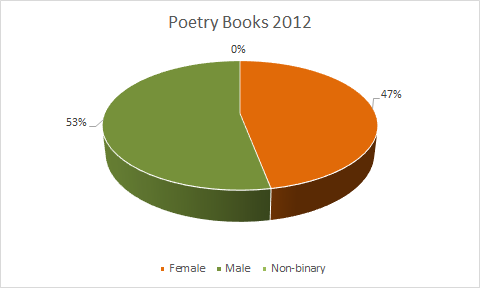
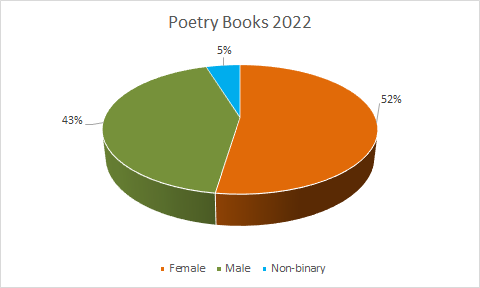
So the overall proportions are not hugely dissimilar, but I would hope that men continue writing poetry and continue getting published.
Ethnicity
The ethnicity of published poets was a sad story in 2011. Of poetry books published in 2011, 61 titles of 65 (94%) were by Pākehā authors, with the remaining 4 (6%) by Māori authors. No Asian, Pasifika or poets of other ethnicities were published in that year.
Things had got a whole lot better for Māori and Pasifika poets by 2021 with 4 titles each (10% of the total respectively) compared with 81% by Pākehā poets (percentages don’t add exactly due to rounding errors). No Asian poets or poets of other ethnicities were published that year.
While an improvement, this is still not reflective of the overall population. Māori were estimated to make up around 15% of the New Zealand population in 2018, Pasifika 7%, Pākehā 63%, Asian 14% and other ethnicites 1%
I’m aware that I’m only looking at poetry on the page and missing out zines, performance poetry and poetry in the digital space. Maybe it’s a whole different story across other media, but I like books I can hold in my hand.
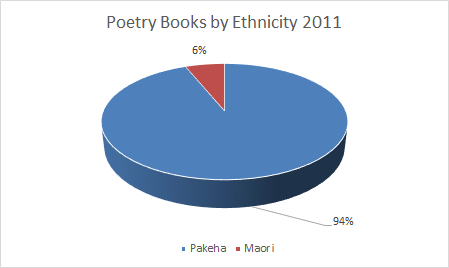

Methodology
I have not conducted proper research. Someone should. This is a quick and dirty analysis of titles listed in the Journal of Commonwealth Literature, which lists an annual round-up of books published in Commonwealth countries in the previous year. It’s accessible online for a fee.
Then I try to find out how each author defines themselves in terms of gender and ethnicity. I usually look at three or more websites (eg author pages on publisher sites, Wikipedia, writers’ websites, the Academy of New Zealand Literature, the NZ Society of Authors). If someone mentions their pronouns or ethnic background, then great, I use that. Gender is usually fairly easy to find. If a poet is using female pronouns, I list them as female, etc.
Ethnicity can be trickier to find. If I’ve looked at several sites and there is no mention of ethnicity or iwi affiliation, I assume the author to be Pākehā. I may miss a few people this way. For books written by multiple authors with different genders and/or ethnicities (eg if a Pākehā man and an Asian woman co-authored a book), I list them as Other. If someone mentions they have a parent who is Māori, Pasifika or Asian, I add the person to the respective group. If someone has Māori and one or more other ancestries, I count them as Māori. It’s not perfect, but it does allow an analysis of trends over time.
If anyone finds errors, please let me know. I do my best, but this stuff is not peer reviewed.
Previous findings
Who Gets Published in Aotearoa? – the 2019 round-up
New Zealand Fiction & Non-Fiction by Gender & Ethnicity 2015
NZ Poetry 2015 by gender & ethnicity
NZ Fiction & Non-fiction by gender & ethnicity 2014
Poetry published in New Zealand, by gender & ethnicity – to 2014
Poetry & Gender in New Zealand Publishing – an occasional series
Poetry & Gender in New Zealand Publishing Part 2
Other Reading
Tina Makereti’s speech/essay Poutokomanawa – The Heartpost – Academy of New Zealand Literature (anzliterature.com)
Michalia Arathimos’ essay: The wharenui of New Zealand literature remains a gated community – E-Tangata
Tusiata Avia, Vaughan Rapatahana, Maria McMillan and Sarah Jane Barnett Why Can’t We All Just Get Along? The Literature Edition – Pantograph Punch (pantograph-punch.com)
Lani Wendt Young Lani Wendt Young on how the digital era is changing writing and reading for the better | RNZ
July 3, 2023
A Kind of Shelter Whakaruru-taha
If you missed the Newtown event celebrating A Kind of Shelter Whakaruru-taha, you can watch it here – thanks Wellington City Libraries!
There’s also a Writers on Mondays event coming up later this month, at Te Papa in Te Whanganui-a-Tara Wellington. Further details here. I will be taking part, along with the amazing Witi Ihimaera, Whiti Hereaka, Sudha Rao, Emma Barnes, Brannavan Gnanalingam, and Helen Rickerby.
When | Āhea Mon 31 Jul 2023, 12.15pm–1.15pm
Where | Ki hea Rongomaraeroa | Te Marae, Level 4, Te Papa
Great to see Writers on Mondays going again!
June 17, 2023
National Flash Fiction Day
National Flash Fiction Day is almost upon us – 22nd June 2023, the shortest day of the year because flash fiction is, well, short. There will be events all over the country, so look out for something in a town near you.
I’m very pleased to be on the shortlist for the NFFD Competition this year, and will be reading my shortlisted story at the Te Whanganui-a-Tara Wellington event.
In Te Whanganui-a-Tara Wellington, you can celebrate some of the shortest stories on the shortest day of the year with Wellington writers and guest readers:
Amber O’Sullivan
Annette Edwards Hill
Ceinwen Curtis
Dame Fiona Kidman
Janis Freegard
Jennifer Lane
Joanna Cho
Kate Mahony
Philippa Werrry
Sudha Rao
Tim Jones
Victoria Quade
*Youth Judge Joanna Cho will be present
*readings of Adult and Youth shortlisted stories
*prize winners announcement
*book giveaways
*sharing of kai (bring a plate if you like)
Timing for the event is 6pm to 7:45pm, Thursday 22nd June 2023

June 11, 2023
Spellcasting

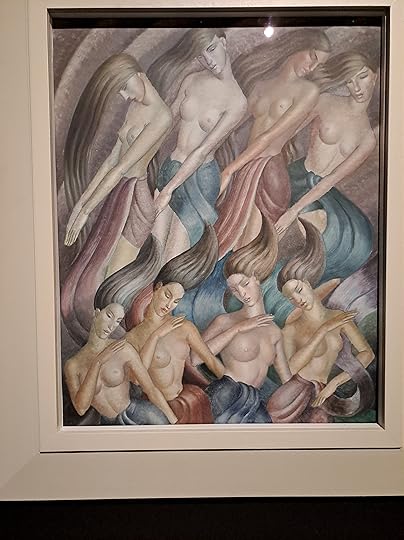



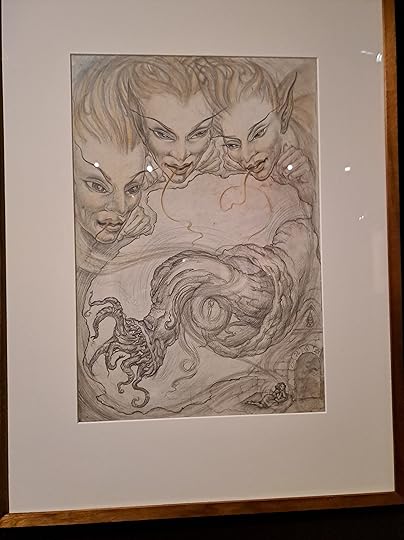
On Saturday 17th June 2023 1pm – 2pm, I’ll be reading poems with the amazing Rachel McAlpine, Rebecca Hawkes, Arihia Latham, Hannah Mettner, Cadence Chung and Harriet Prebble, in response to the Sisterly exhibition at the Dowse in Lower Hutt.
Sisterly features work by A. Lois White, Rosaleen Norton (‘the witch of King’s Cross’), and Jen Alexandra. More info here and here.
June 8, 2023
Whakaruru-taha
Recently, I had the great pleasure of being part of a launch event for A Kind of Shelter Whakaruru-taha, with the inimitable Witi Ihimaera, Michelle Elvy, Tina Makereti, Pip Adam, Gregory O’Brien, Ya-Wen Ho, Noa Noa von Bassewitz, Sudha Rao, Whiti Hereaka, Emma Barnes and Nicola Leggatt from Massey University Press. Many thanks to the Newtown Library for hosting.
More about the anthology below (source: Wellington City Library website). You can listen to Part 1 of the event via a recording on Access Radio. I’ll add Part 2 when it’s available.
“A Kind of Shelter Whakaruru-taha is a major anthology of new writing, featuring some of Aotearoa’s most eminent writers, artists and thinkers considering what our shared future might hold. The book is a series of rich conversations, just a few of the hot button topics the authors look at include: decolonisation, indigeneity and climate change. A Kind of Shelter Whakaruru-taha is arranged according to the principles of whaikōrero.”A Kind of Shelter Whakaruru-taha is a major anthology of new writing, featuring some of Aotearoa’s most eminent writers, artists and thinkers considering what our shared future might hold. The book is a series of rich conversations, just a few of the hot button topics the authors look at include: decolonisation, indigeneity and climate change. A Kind of Shelter Whakaruru-taha is arranged according to the principles of whaikōrero.
The anthology, co-edited by Witi Ihimaera and Michelle Elvy, embraces a wide spectrum of voices and a multiplicity of views for readers to consider. The writers included also hail from a wide variety of artistic and professional practices, including: poets, anthropologists, fiction writers, architects and academics.”
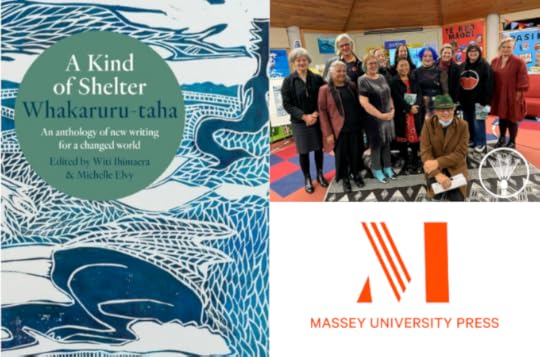
The lovely Constance Talbot made a video of me reading (reproduced with Constance’s permission):
January 8, 2023
Ngā Mihi o Te Tau Hou Pākehā
Happy New Year! It’s been a rough few years globally. Here’s hoping we turn a corner.
A nice thing happened at the end of last year – a few lines from one of my poems was included in an excellent prize-winning essay by Padmasayee Papineni, a Consultant in Infectious Diseases and Acute Medicine in London. Dr Papineni’s essay was published in The Lancet and is about compassion in treating tuberculosis. Feeling very honoured to have made a tiny contribution. The poem is The Lift.
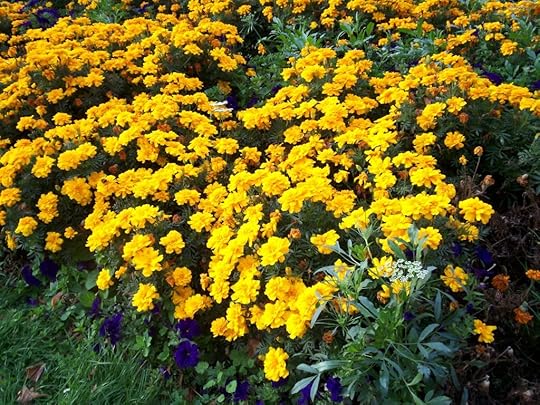
Also last year, the poem I wrote for the Dante anthology, More Favourable Waters (The Cuba Press) appeared in Miglior acque. 33 poeti neozelandesi e italiani rispondono al Purgatorio di Dante, (Marco Sonzogni and Matteo Bianchi, Samuele Editore 2022). The translator is Franca Mancinelli and the translation can be read here.
I love it when my work goes on to have adventures without me.
August 25, 2022
Happy Poetry Day
It’s Aotearoa’s National Poetry Day today and the Meow Gurrrls are celebrating with a series of poetry videos we uploaded recently to our Youtube channel: ‘Papatuanuku’ by Abra Sandi King, ‘Our Need’ and ‘Stroke’ by Mary Macpherson, ‘To My Daughter’ and ‘Desire Undressed’ by Sudha Rao, and my own ‘Too Late for the Manatees’ and ‘Again the Gemini’. Shout-out to Landfall for publishing ‘Too Late for the Manatees’ and the 6press for publishing ‘Again the Gemini’.
Meow Gurrls Mary Macpherson, Mary-Jane Duffy and I will be on Radio Active‘s Caffeine and Aspirin show at 10:30am tomorrow (27th August 2022), following on from Sudha Rao and Rewa Morgan who were interviewed on Caffeine and Aspirin last week.
August 17, 2022
Polly
Yesterday we said goodbye to the light of our lives. Our dear little friend has departed for the Great Cat Paradise in the Sky. No doubt she is already bossing the cherubs about and careering down heavenly corridors at breakneck pace. For fourteen years she has charmed, delighted and terrorised us and we miss her desperately.
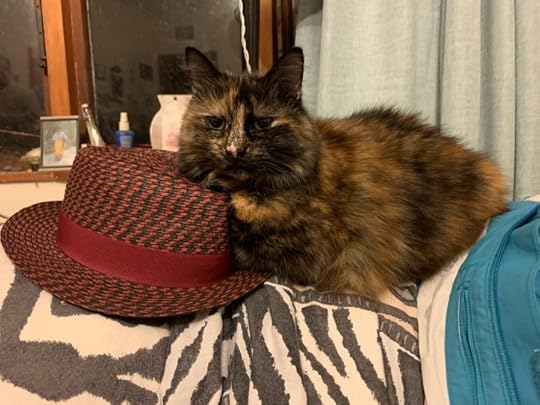
Polly’s interests included butter, bird-watching, sitting on Peter’s feet, eucalyptus-scented tissues, brown paper bags, doorframe demolition and being fluffy. Her more egregious moments included chewing through the cord for the landline the day she moved in, biting into an artery in my hand so that it swelled to twice its natural size, establishing a small colony of mice in the house by bringing them in one live mouse at a time, and biting my ankles any time I sang or played guitar. On the plus side, she once brought me the thoughtful gift of a small dead rat and looked quite surprised when I yelled at her to take it outside. Instead she ate the tail and left me the rest.
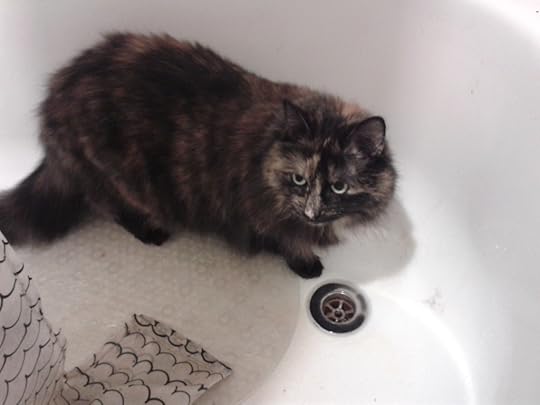 Water station
Water stationWe think Polly was about two when she shifted herself into our home and took over. We’ll never know her back story, but speculated that her previous household had moved to escape her bad behaviour. She was playful, cantankerous and completely endearing. It’s been our honour and pleasure to be Polly’s devoted staff, and while her own assessment would no doubt be ‘could try harder’, we did our best to make her happy. Farewell, little fluffy one. The house is very empty now.
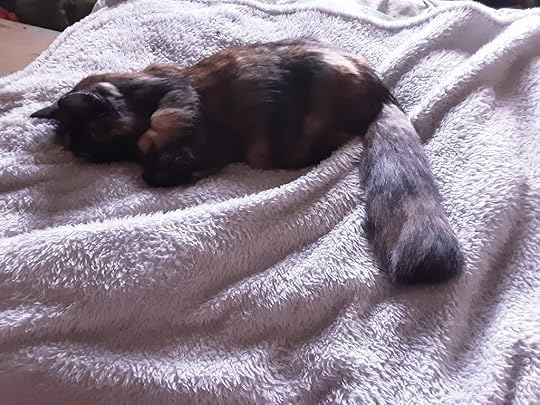 That tail, though
That tail, thoughThis is a poem I wrote for Polly a while back. It was published in the Meow Gurrrls zine, Meowing Part 1.
MistressMy little queen
My steel-clawed directress
My feaster-in-chief
My fantail watcher, skink catcher, snoozer supreme
My hair-shedding, door-scratching,
skin-shredding boss of the house
Oh when I am dead, when I am finally gone
Then you may bite through
the softest, most delicious part of my cheek
And with the diligence you show to your elegant coat
clean all the meat from my bones
February 10, 2022
Who Gets Published in Aotearoa? – the 2019 round-up
Yes, yes, I know it’s out-of-date and I haven’t done it for ages.
The Back Story
For some years now, I’ve been looking at book titles published in New Zealand in any given year, broken down by the gender and ethnicity of authors. To start with (in 2008), I just looked at poetry titles by gender. I did this because I was curious to know what the proportions were (in 2008, 63% of titles were written by men; 36% by women and 1% other (co-authored by a man and a woman)).
Later, I started looking at ethnicity as well, also driven by curiosity: how level is the publishing playing field? Is it easier for Pākehā to get published compared to Māori, Pasifika, Asian and other authors? This matters to me because I like things to be fair and because I don’t want to just read stuff written by people like me. (For the record, I’m Pākehā, born in the UK, and I’ve lived in Aotearoa since I was twelve. My pronouns are she/her.)
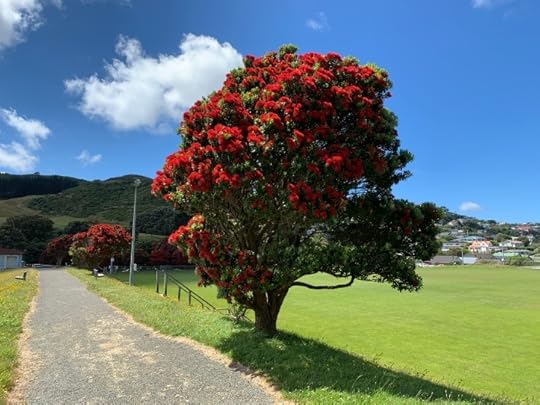 Level Playing Field with Pōhutukawa
Level Playing Field with PōhutukawaLater still, I added fiction titles to the list, then non-fiction. I published the analysis on this blog over several years and hoped it might be useful in some way. I’ve been really pleased that my findings have been able to support calls for a more representative national literature, including Tina Makereti’s excellent talk, Poutokomanawa — The Heartpost (well worth a read), at the Auckland Writers Festival on 17 May 2017.
I didn’t repeat the analysis for 2016, 2017 or 2018. I had good intentions, but it takes days and days to do it and I was focusing on other things. However, last year I analysed the titles published in 2019 – but didn’t get around to blogging about it because life got in the way – so here at least is a comparison that can be made between 2015 and 2019, in case anyone is interested. I also have data for poetry titles for 2011, so I’ve added that into the mix. If I find the time to analyse the data for 2020 and/or 2021, I’ll blog about it later this year. (There’s always a delay, because the information I use is published months after the end of each calendar year.)
The Findings:
Poetry – Gender
With poetry, there was a switch in the gender balance between 2015 and 2019. In 2015, 56% of poetry titles published in New Zealand were written by men and 44% by women (slightly more balanced than the 58% men, 42% women in 2011) . In 2019, 56% of poetry titles were by women, 43% by men and 2% by a non-binary poet. (Sometimes the figures will not add to 100% due to rounding errors.)
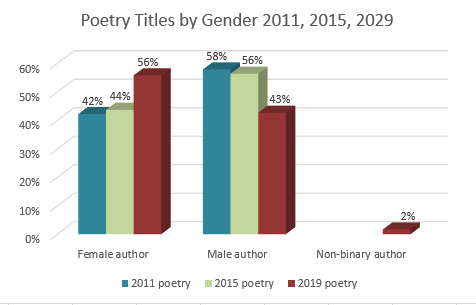
So, all good if there are a few more blokes published in one year and a few more sheilas the next. Hopefully it will settle into an equal-ish sort of distribution. I don’t know what proportion of the population identify as non-binary, so I can’t comment on whether 2% (1 poet out of 61) is reasonably representative. But it’s a start and maybe we’ll have some data after the next census.
Poetry – Ethnicity
Ethnicity is a much sorrier story. Of poetry titles published in 2019, a full 95% (58 titles) were by Pākehā authors. Yep, leaving 2% each for Māori, Pasifika and Asian poets (ie 1 book each). To put it in context, around 17% of New Zealanders are Māori, around 15% are Asian and around 8% are Pasifika.
I honestly thought things would have got better. This is some serious under-representation in our national literature right here. I know some publishers have been making sterling efforts to address that – please keep going.
Here’s the miserable poetry pie chart that illustrates how things were in 2019. Pākehā poets were getting a whole lotta delicious poetry pie and 3 poets who weren’t Pākehā managed to get some crumbs. We poets are all very hungry for the pie and there’s less and less of it about, but this is a very sorry state of affairs.
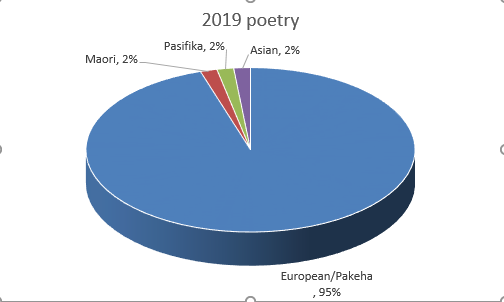 Poetry Titles NZ by ethnicity of author
Poetry Titles NZ by ethnicity of authorLani Wendt Young has written about the impact of the digital age (Lani Wendt Young on how the digital era is changing writing and reading for the better | RNZ) and maybe it’s the case that Māori and Pasifika poets are more drawn to digital media – it would be interesting to look at who is performing their poetry live or online and who is publishing on Instagram or other online media. But I’ve only looked at poetry on the page and it looks dismal.
Dwindling supply of poetry
In more general bad news for poets, it is harder to get a book published these days than it was in 2008, when I first looked at the poetry stats. In 2008, 88 poetry books were published; in 2019, it was 61. That’s a 31% drop over eleven years. Many thanks to all the wonderful publishers out there who continue to do this as a labour of love.
It’s possible some publications have been missed (I rely on the Journal of Commonwealth Literature for information) and there is also a healthy zine scene out there that I don’t include, but still. Is it just that everyone’s on Tik-Tok and Insta these days and there’s less demand for poetry you can hold in your hand?
Fiction – Gender
So, fiction’s got to be better, right?
Well, the news is that the laydeez have taken over, leaping from 59% of titles in 2015 to 71% of titles in 2019. Which is – um – great in some ways – but I want to read stuff from the chaps as well. So, gentlemen, step up and get writing them novels, and publishers, please don’t discount a novel just because it’s written by a bloke  (If anyone’s wondering what ‘Other’ is in the graph, these are usually novels written by multiple authors who are different genders eg a novel co-authored by a man and a woman.)
(If anyone’s wondering what ‘Other’ is in the graph, these are usually novels written by multiple authors who are different genders eg a novel co-authored by a man and a woman.)
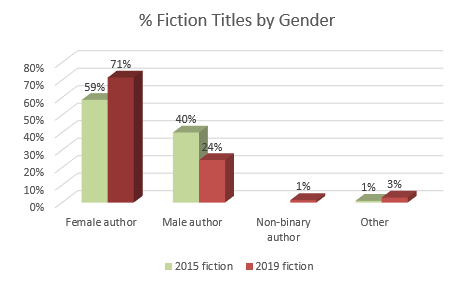
Fiction – Ethnicity
Ethnicity stats for fiction have changed quite a bit between 2015 and 2019 too, in a good way. In 2015, 91% of fiction titles were by Pākehā authors, 4% each by Māori and Asian authors and only 1% by Pasifika authors. By 2019, 7% of titles were by Māori authors, 7% by Asian authors and 6% by Pasifika authors. This does not come close to reflecting the proportion of Māori, Pasika and Asian people in the population, but at least it’s heading in the right direction. In any case, I wouldn’t expect there to be an exact match because of the different population structures of different groups (the Pākehā population is skewed towards older age groups; Māori and Pasifika peoples have more youthful population structures).
The population structure of writers overall would be different again, skewed towards older age groups with fewer writers under 30. (And that’s okay because it takes time to learn our craft. I remain grateful that most of my early endeavours have not seen the light of day, although ‘Bonfire Night’ as published on the wall of my classroom when I was six remains a triumph. On reflection, however, I do feel that ‘rockets in the sky’ would have been a better line than ‘bangers in the sky’. But I digress.) In any case, these proportions may be slightly better than they look at first blush.
Overall, there were 75 fiction titles published in 2015, reducing to 70 in 2019. Not enough data to know if this is a trend.
[image error]Non-fiction
I included Letters and Auto/biography, but left out Criticism and Translations.
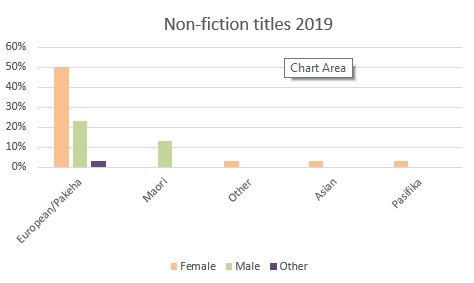
77% of authors were European/Pakeha; 13% were Maori; 3% were Asian, 3% Pasiifka and 3% other ethnicities. 60% of authors were female; 37% male and 3% other (one book was jointly edited by a man and a woman). So not too bad overall, although I’m surprised there were not more men writing non-fiction. In 2015, 62% of non-fiction writers were male; 38% female. Numbers are small, so maybe it fluctuates a bit year on year.
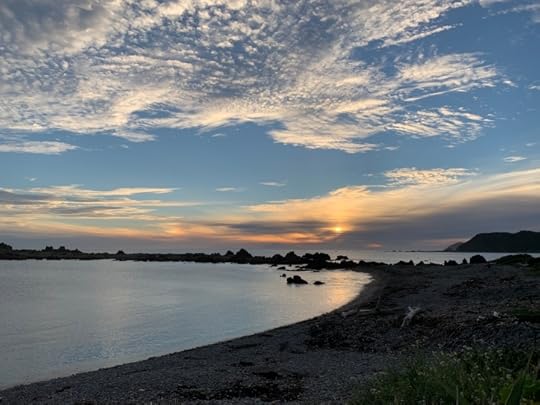 Photo to break up a post that’s gone on too long
Photo to break up a post that’s gone on too longConclusion
I don’t know. Maybe writers, especially young writers, are moving into more democratic forms of publishing – like self-publishing online. In the meantime, the distribution of pie may have improved in some respects, but it’s still looking pretty skewed, especially in the poetry world.
Methodology
I make no claim to have conducted proper research. I have performed a quick and dirty analysis of titles listed in the Journal of Commonwealth Literature, which publishes an annual round-up of titles published in Commonwealth countries in the previous year. It’s accessible online for a fee. Then I try to find out how each author defines themselves in terms of gender and ethnicity. I usually look at three or more websites (eg author pages on publisher sites, Wikipedia, writers’ websites, the Academy of New Zealand Literature, the NZ Society of Authors). If someone mentions their pronouns or ethnic background, then great, I use that. Gender is usually fairly easy to find, although if someone has changed their gender identity since publication. I may not have picked it up and they may be sitting in the wrong category.
Ethnicity can be trickier to find. If I’ve looked at several sites and there is no mention of ethnicity, I assume the author to be Pākehā. I may miss a few people this way. For books written by multiple authors with different genders and /or ethnicities (eg if a Pākehā man and an Asian woman co-authored a book), I list them as Other. If someone mentions they have a parent who is Māori, Pasifika or Asian, I add the person to the respective group. It’s not perfect, but it does allow me to look at trends over time.
If anyone finds errors, please let me know. I do my best, but this stuff is not peer reviewed.
Other Reading
Tina Makereti’s speech/essay Poutokomanawa – The Heartpost – Academy of New Zealand Literature (anzliterature.com)
Michalia Arathimos’ essay: The wharenui of New Zealand literature remains a gated community – E-Tangata
Tusiata Avia, Vaughan Rapatahana, Maria McMillan and Sarah Jane Barnett Why Can’t We All Just Get Along? The Literature Edition – Pantograph Punch (pantograph-punch.com)
Lani Wendt Young Lani Wendt Young on how the digital era is changing writing and reading for the better | RNZ
My previous blog posts on this:
New Zealand Fiction & Non-Fiction by Gender & Ethnicity 2015
NZ Poetry 2015 by gender & ethnicity
Poetry & Gender in New Zealand Publishing Part 2
Poetry & Gender in New Zealand Publishing 2008 – 2010
Poetry & Gender in New Zealand Publishing – an occasional series
Poetry and Gender in New Zealand Publishing – the latest
Poetry published in New Zealand, by gender & ethnicity – to 2014
NZ Fiction & Non-fiction by gender & ethnicity 2014
December 13, 2021
Joanne
I’m very pleased that my poem (ocean beach road) is in the latest edition of Turbine/Kapohau. The poem is about my little sister, Joanne. Ocean Beach Road in Whangarei Heads is where we lived when the signs of Joanne’s rare condition, Sanfillippo syndrome (a type of childhood dementia – surely one of the cruelest diseases), were becoming more noticeable. This photo would have been taken when she was 8 or 9, part of a series of photos my parents took to remember her, as doctors, unsure of a diagnosis, had told us she only had a few months to live. We finally learned what was wrong about ten years later. Joanne was 37 when she died in 2005. You don’t stop being a sister just because your sister dies.
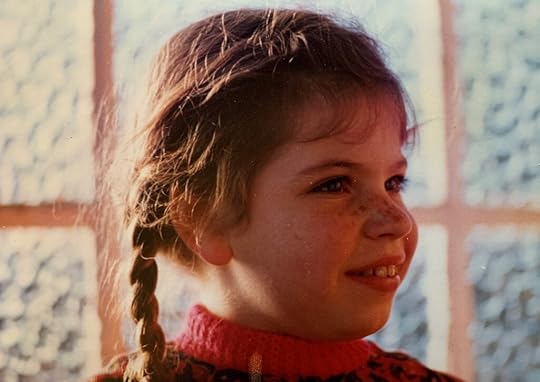 Joanne Freegard
Joanne Freegard



